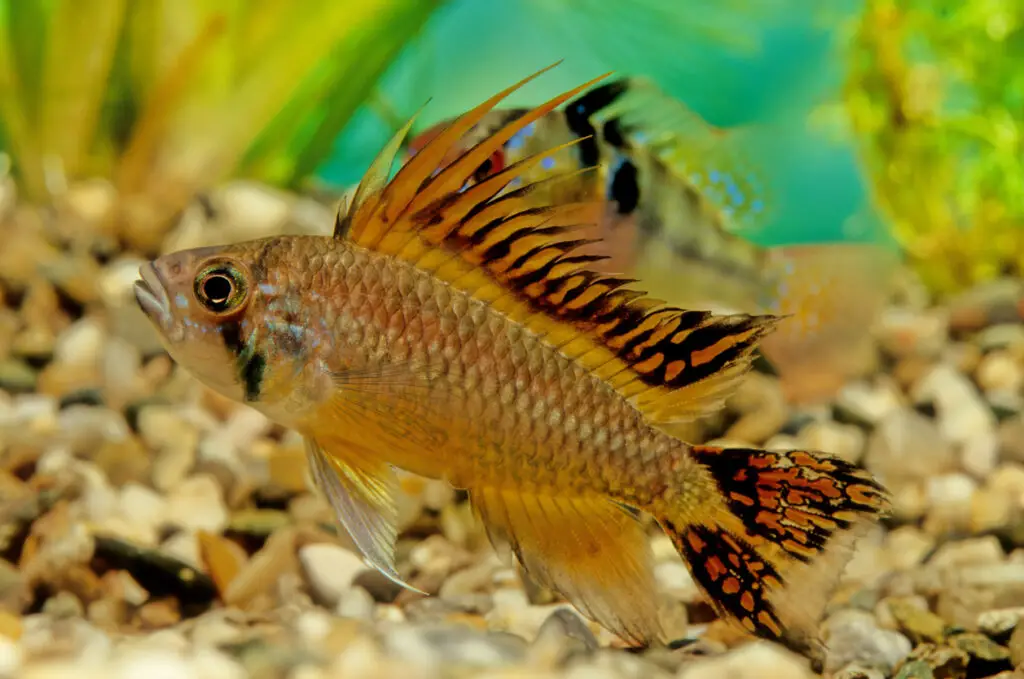A fun fish to consider for your aquarist hobby list is the Apistogramma cichlid. These small fish, sometimes called dwarf cichlids, are spunky, energetic little guys that can really add some fun and flare to your fish tank.
These little fish are full of energy, color, curiosity, and come in a wide range of colors and good looks.
They do great in community tanks (though, of course, you have to choose their tank mates carefully!).
They also love to put on a show with their spunky little energy bouts that send them whizzing around the fish tank.
Apistogramma cichlids are often known as dwarf cichlids (and yes, they’re pretty small!) – so if you see that name while you’re shopping for one, you’re in the right place.
These little guys hang out toward the bottom of the tank, making them great matches for mid-level and top level swimmers in a community freshwater aquarium.
Just know that they need to be stocked into aquariums at least 20 gallons in size to happy, healthy, spunky them!
Apistos is the affectionate nickname for these spunky, semi-aggressive little fish. They’re loaded with personality and curiosity and absolute make for one of the best freshwater fish you could house in your community tank.
This is especially true because they’re actually known for interacting with their owners! They come right up to the tank walls when you look in.
Quick Intro to Apistogramma Cichlids
| Family: | Cichlidae |
| Scientific Name: | Apistogramma Cichlid |
| Other Names: | Apistos, Dwarf cichlids |
| Care Level: | Moderate to difficult |
Natural Habitat, Identification, and Where to Buy Apistogramma cichlids
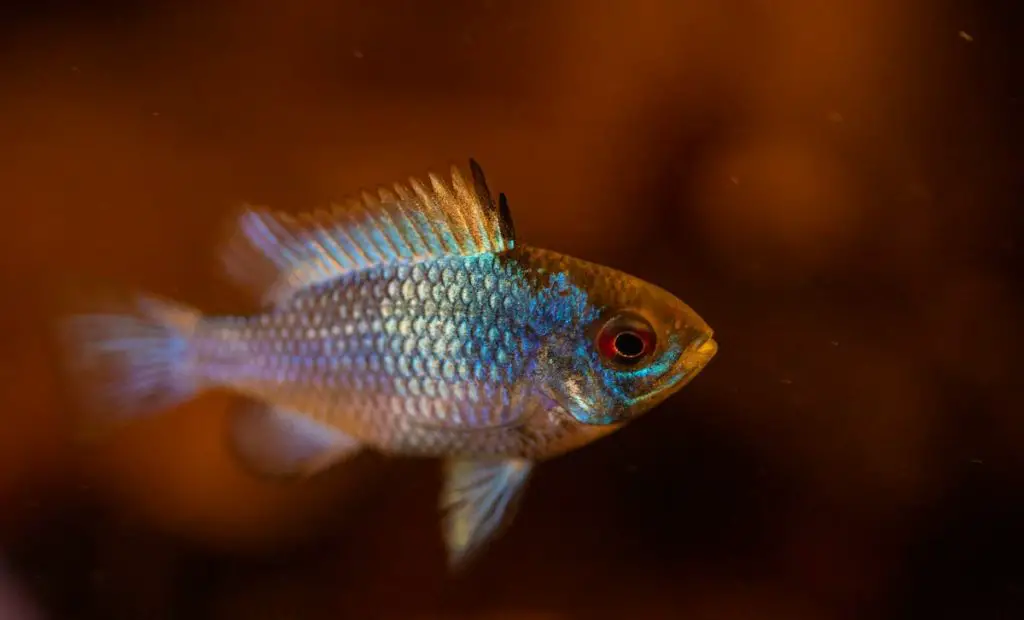
Over 90 species of dwarf cichlids exist, all of which are of South American origin.
With so many types of dwarf cichlids, there are various needs but things that all members of this species need are shallow warm water and lots of aquatic plants.
This species of fish like to live in water that has available shade. Naturally, their Amazon River in Peru, Brazil and other locations, has both soft and acidic water.
They prefer sandy substrates that they can burrow into. They like to be able to swim in and around various things like plants, driftwood, and empty shells that can offer plenty of places for them to hide.
This fish species is known for having eye-catching colors. The colors will be different depending on gender, type, and breed of cichlids.
The males stand out from the females because of how bright and vivid their colors are (if you are interested in breeding this species, it’s important to remember the color difference).
The dwarf cichlid is smaller than other cichlids and makes for a great choice when you have a smaller tank or you just want to have a larger number of fish.
For this species to grow to its full size it is important to make sure they have enough space in the water.
This fish is not the best choice for those who are starting in fishkeeping freshwater aquariums. While inexperience shouldn’t be the only reason to not choose to fish, it is important to know what you are getting yourself into.
If you are willing to take the time it takes to learn what these fish need, they are well worth the effort.
These little guys aren’t the absolute cheapest pet fish out there, but they’re not expensive either. Most folks report finding them for about $10 to $15 a piece, if not cheaper.
Author Note: Do keep in mind, though, that the fancier the coloration (think peacocks dwarf cichlids), the more expensive they will become.
But if you’re not into the crazy color schemes, you could easily stock your tank on the cheap.
When you are looking to buy them, they are affordable fish. The average price per fish ranges between $11-$13 at the average pet store.
Optimal Water Conditions for Apistogramma Cichlids
| Water Temperature: | 72-86 F |
| Water Flow Rate: | Very light, slow-moving |
| pH: | 5-5 – 6.8PH |
| Water Hardness: | 0-8 dH |
Tank Setup
| Minimum Tank Size: | 20 gallons |
| Optimal Tank Size: | 25 gallons per pair |
| Optimal Tank Shape: | Standard |
| Recommended Filtration Type: | High-powered filters |
When putting together your tank for this species, it is important to have a high-quality filter with carbon to meet their needed water parameters. A good choice recommended by hobbyists is the AquaClear power filter.
This fish gravitates toward still water in nature so they need a filter that can be set at low power to recreate that. If the lowest setting of the filter is not low enough you can add a baffle to your tank.
Dwarf Cichlids are known for having a very demanding need for exact water temperatures. Depending on the species they may need water that is acidic and very soft, however, most just need moderately soft water and only with slight acid.
With looking for water as long as the water is being filtered through an RO filter, like at a grocery store, then the water should be of sufficient quality for your fish.
This commercially available water should have no hardness and have a neutral pH level.
Purchasing water by the bottle from a store can become very expensive over time so some fish keepers prefer to prepare their own. If you are unable to find the water that you need, it may require using reverse osmosis.
Several dwarf cichlid variations can be kept and bred in alkaline water. However, there are only a few who can thrive in this type of water. The fishes that can’t handle this type of water will not grow as big or have as bold coloration.
This type of water can make spawning difficult because of the eggs not being able to be fertilized.
No matter what kind of water your tank has, there need to be frequent water changes. In the wild fish can have access to frequent freshwater because of the constant flow.
Since it is incredibly expensive to set up a constant flow system for your aquarium, the next best thing is to provide fresh water by changing the tank’s water.
Most fish keepers suggest changing 20% of the water every two to three weeks at the bare minimum.
If you currently have spawning adults or growing young fish the water requirements are much stricter.
Approximately 40% of the tank’s water should be changed every other day, some suggest upwards of 70% depending on the number of fish in your tank.
For those who are new to keeping dwarf cichlids, it is suggested you purchase a water testing kit. This will include strips, meters, and a color kit. This is the best way to know how your water level is and when exactly it needs to be changed.
If you want to take this to the next level, keep a journal of your water levels so that you can learn the rhythms of your aquarium and how exactly your fish are.
Creating the Landscape
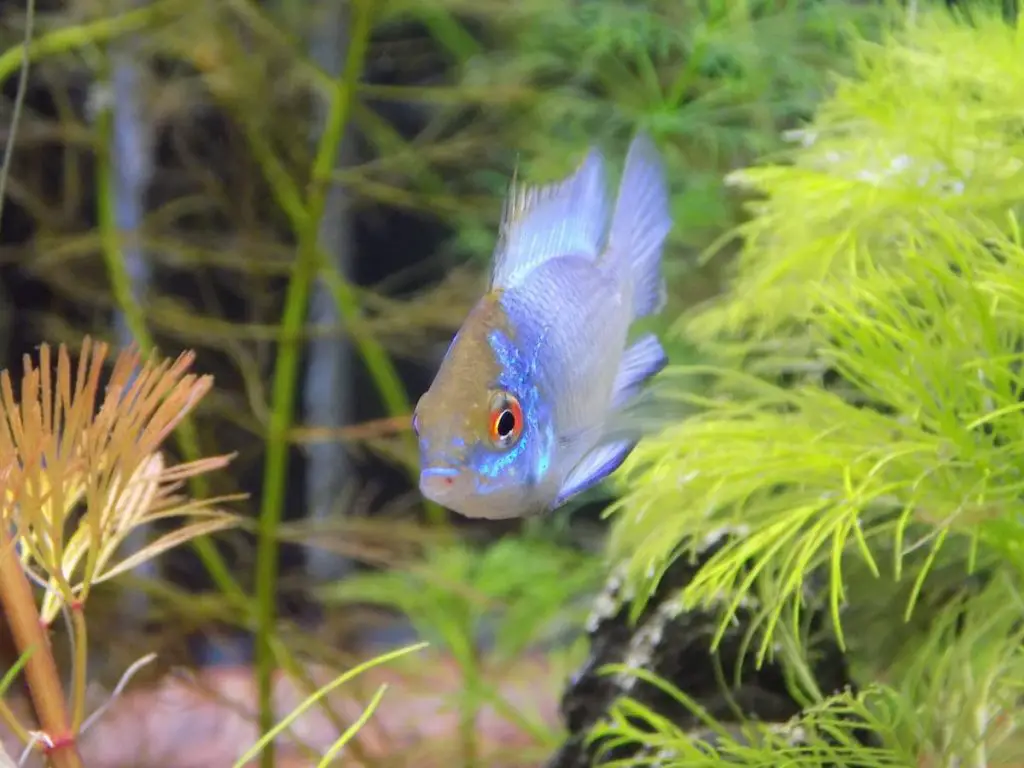
When creating a first time tank for your Apistogramma, it is suggested starting with a ten-gallon tank that uses a sponge filter for keeping the water clean.
For your fish to be healthy and feel happy it is important to make sure that the filters are running at a low setting. The lower water flow mimics the natural habitats that they are from, so it helps encourage the fish to breed.
In their wildlife habitat, this fish is used to have dead leaves floating on the surface that they can use for shadows to hide in.
There is no need to use dead leaves, you can just as easily make shadows using floating plants, planted plants, driftwood, and rocks.
If you are planning on breeding your fish, live plants can act as a place for them to spawn in your tank.
When it comes to lighting up the aquarium, it is important to strike a balance. You need a LED light that is bright enough to help your plants grow, but not so bright it interferes with the fish.
The great thing about using LED lights is that they do not generate a lot of heat while still giving enough light for life to thrive.
This species of fish do not like to be around direct sunlight or especially bright lights, however, the light is needed to help the plants that are put in the tank to grow.
The plus side of having floating plants is that they will provide shade for your fish when the lights are turned on.
Dwarf cichlid has shown a preference for life plants over plastic plants.
There are a large number of live plants that you can pick that will help your fish feel right at home. As sensitive as this species of fish is important to pick plants that will be beneficial for the fish.
As far as substrates for the aquarium, sand is the best choice that you can go with. Sand is a cheap material that can be easy to find in either brick and mortar pet stores or online.
Cichlids are a species that needs live food for maximum nutrition. They are a species of fish that are opportunistic feeders and will happily hunt down whatever food you put in their tank for them.
The live food will help bring out the best colors and make sure they are energetic. If you are planning on breeding your fish then you will want to feed them live food.
Brine shrimp are one of the best choices for live food, you just have to feed your fish once or twice a week. Other great choices for live food include various kinds of worms.
| Best Plants: | Java moss, Java fern, Flame moss, Helanthium tenellum, Cryptocoryne, Water sprite, Ceratopteris thalictroides |
| Best Lighting: | Moderate light, and LED light with settings that are strong enough for the plants to grow but weak enough that it won’t harm the fish |
| Best Decorations: | Plants, driftwood, hiding places like caves or overturned flowerpots, and rocks |
| Decorations to Avoid: | Avoid the use of plastic plants |
Physiological Considerations for Apistogramma Cichlids
| Size: | They grow to a length between 3 and 3 ½ inches long |
| Lifespan: | With proper care, between five and ten years |
| Temperament: | Peaceful |
| Preferred Tank Region: | Bottom to middle regions |
| Scale Thickness: | Nothing to note |
| Gill Considerations: | No particular concerns beyond normal clean tank care |
| Swimbladder Considerations: | Be sure to avoid overfeeding them to help avoid issues |
| Fin Shape Considerations: | Avoid sharp or jagged edged objects that may snag their fins |
With the proper care, Apistogramma Cichlids can live anywhere between five and ten years long. After around four months the fry can reach sexual maturity.
They are aptly named as a fish compared to other cichlid species; they are shorter. After they are fully grown, they reach a length anywhere between 3 and 3 ½ inches, with the males being slightly longer than the females.
Types of Apistogramma Cichlids
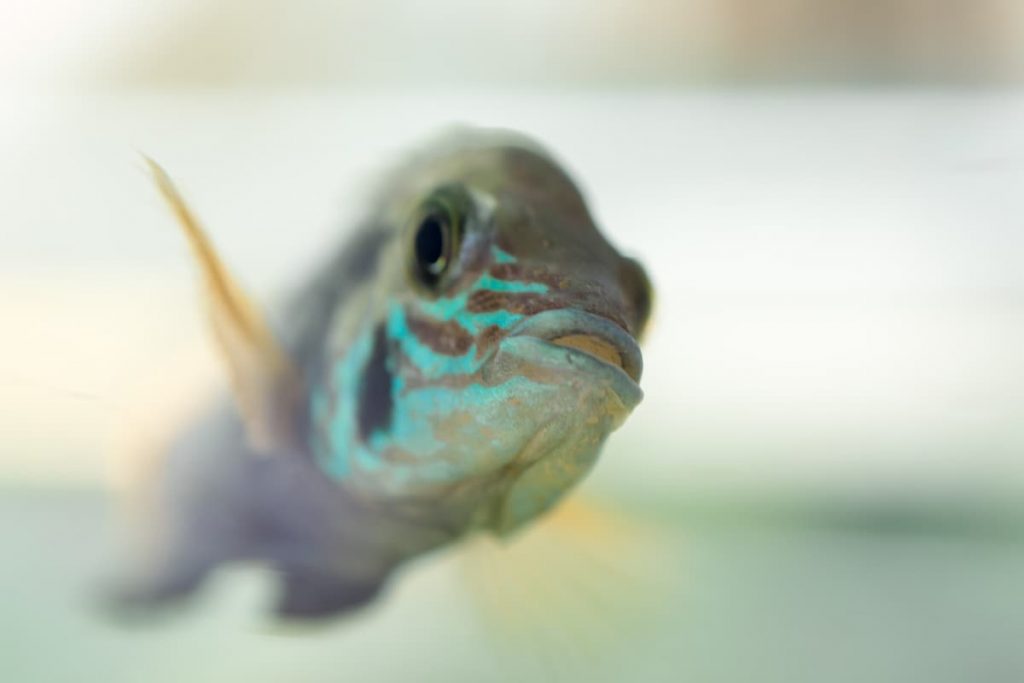
There are several varieties of Apistogramma Cichlids that are readily available to buy.
Yellow Dwarf Cichlid
Yellow Dwarf Cichlids are known for having blue and yellow colors that help them stand out. They are known for being a fish that is peaceful and adaptive, so they are able to work great in a community tank.
As they are from an environment that has a naturally changing habitat, they can live in quite a wide range of pH levels and temperatures
Cockatoo Dwarf Cichlid
The Cockatoo Dwarf Cichlid is named for its bright-colored fins which help make it one of the more popular of all the dwarf cichlids.
Adding to its popularity is how easy they are to both breed and care for (like Blue Crayfish). For anyone looking for a starting Apistogramma Cichlids, then this is the best one to pick.
Apistogramma Sunset
This fish was named because of the easy to recognize yellow floor on the females when they are ready to breed.
Besides the bright color, it is a fish known for being easy to adapt to various situations, which adds to its popularity among fish keepers.
Agassiz’s Dwarf Cichlid
The Agassiz’s Dwarf Cichlid is a territorial but beautiful fish. They require more room than other Cichlids, as well as having plenty of places to hide to reduce their anxiety. It is important to find the right tank mates for this fish to ensure you have happy fish.
Society
Apistogramma Cichlids are known for being an easy-going and social species of fish, so it makes sense to include other fish with them.
They are curious fish that likes to explore their tanks, meet other fish, and will interact with the world outside their tank.
In nature, they will travel in schools so when they live in tanks, they appreciate having other fish of a similar temperament and size that they can swim around with.
Keep in mind that while they are known to almost always be peaceful they are known to become aggressive during breeding times and if they do not have enough personal space in their tank.
Top Tip: The easiest choice for tank mates is to simply choose other Apistogramma.
When choosing the fish for the tank, keep in mind that the close you can recreate their natural habitats then the happier the fish can be.
In nature, a single male will surround itself with a number of female fish that ranges from four to six. If you have too many males they will start to attack each other over keeping female’s attention.
When you start shopping around for tank mates, it is important to remember a few things. First, it’s important to remember that while these species are not predators by nature, they can be at risk of becoming prey to larger fish so it’s important they be around fish of a similar size.
It is important to avoid mixing them with fish that are known for biting fins because it is easy for the dorsal fins of the male dwarf cichlids to be damaged.
It’s normal to expect different species of fish to have different behaviors, sometimes two fish of the same species even have radically different behavior patterns.
Author Note: These behaviors are rooted in their environment, how chaotic their life is, how much regular access to food they have, and the water quality.
Fish you can safely keep with your Apistos include:
- Fish of the same species
- Otocinclus catfish
- Black skirt tetras
- Neon tetras
- Pencil fish
- Cardinal tetras
- Splash tetras
- Pygmy cories
- Galaxy Rasboras
- Other Rasboras
- Pygmy Corydoras
- Bristlenose Plecos
Gender, Breeding, and Reproductive Considerations
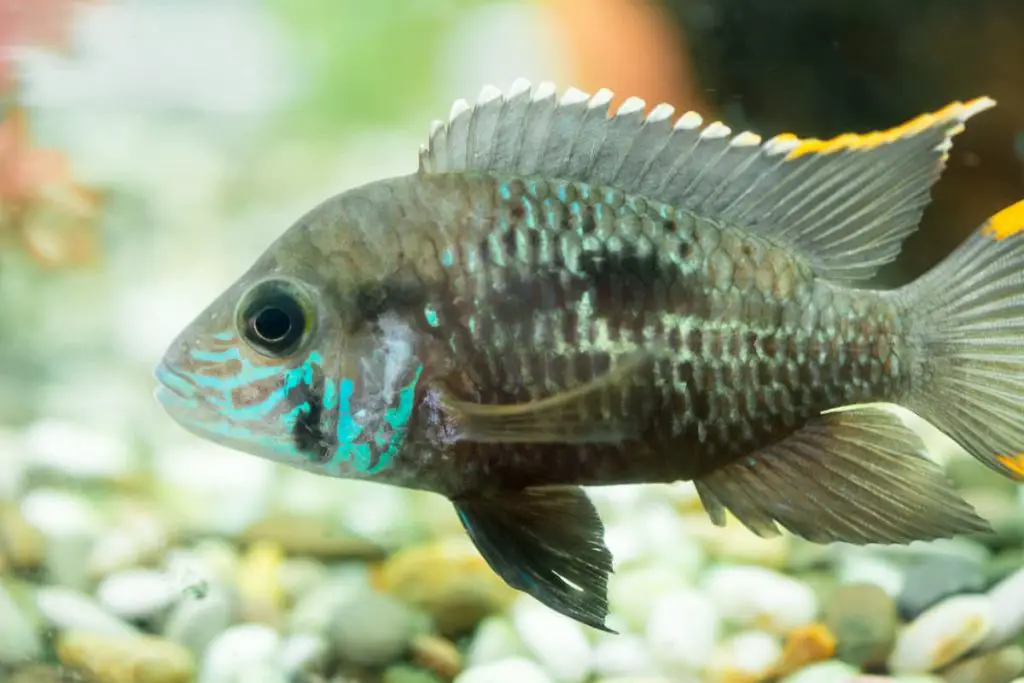
This fish species is easy to breed. If you were interested in starting fish breeding then this is a great species to start with.
One of the first things to be aware of when preparing for your fish to mate is that in nature they do not have much of a current in the waters they occupy.
If there is too much water movement it will disturb the process and waste all the other prep you have put into this project. If you purchase a baffle for your filter it should lower water disturbance to the point the fish will not be bothered.
To increase the chances of successful breeding, it is good to have several females to one male. One of the few things that will cause the male fishes to fight is if there is competition when it comes to breeding.
Most fish breeders use a separate tank for fish breeding. This reduces the likelihood of the eggs and fry being eaten by other fish.
If you decide to breed in the same tank that the fish live in, you will need to move the fry as soon as they are born.
Besides the fry being eaten, there is a chance that one of your fish may become seriously injured as the momma fish won’t take kindly to someone trying to make a meal out of her children.
To start the breeding process you need to move either a bonded pair or a male with several females. The females of this fish species will turn more yellow in color as they are ready.
The setup for the breeding tank is similar to the main tank except you need to make sure there are plenty of places for the fish to have privacy while they mate.
The water for the breeding tank needs to be slightly warmer than the main tank. As this species of fish is incredibly sensitive to any contaminants in the water, it is suggested to change at least 10% of the water every day.
Fish keepers suggest using a product like Otocinclus to keep a handle on the algae that tends to grow on both the plants and aquarium walls.
Top Tip: Remember, the more effort you put into the water quality for your fish, the happier and healthy they and their fry will be.
The mother fish will care for her fry until they are about four weeks old. The fry needs to be kept separate from the main tank until they reach maturity and are able to take care of themselves.
Nutritional Needs
This species of fish does best when you are feeding them live food. There are a variety of great food choices that will keep them healthy and happy. Glass worms, larvae and baby brine shrimp are all great choices.
However, as this fish is an omnivore, they are happy to eat plant matter as well. This can be either alga that normally forms in your tank or they may take a nip on plants that you have put in their tank.
In order to make sure your fish has a balanced meal, picking a high-quality food pellet is important. There are a number of sinking pellets that offer a lot of dense nutrition.
Your fish should only be fed once or twice a day. When your fish is fed, watch and see how much they eat within a one to two-minute window.
Top Tip: Try to balance things so that your fish have no leftovers. If there is any leftover food make sure to remove it from the tank as soon as possible. Food left to rot can pollute your tank and make you fish sick.
If you notice any aggression in your fish it is important to make sure they are getting fed enough food.
| Best Sustenance Food Type: | Worms, larvae and baby brine shrimp |
| Additional Food For Optimal Health: | Plants in your tank and high quality food pellets |
| Special Foods and Considerations for Best Color and Growth: | Live food is the best for their health and color |
| When and How Often to Feed Fish Based on Life Cycle: | Feed your fish only what they can eat in 2-3 minutes, once or twice daily |
Common Diseases and How to Avoid and Treat Them
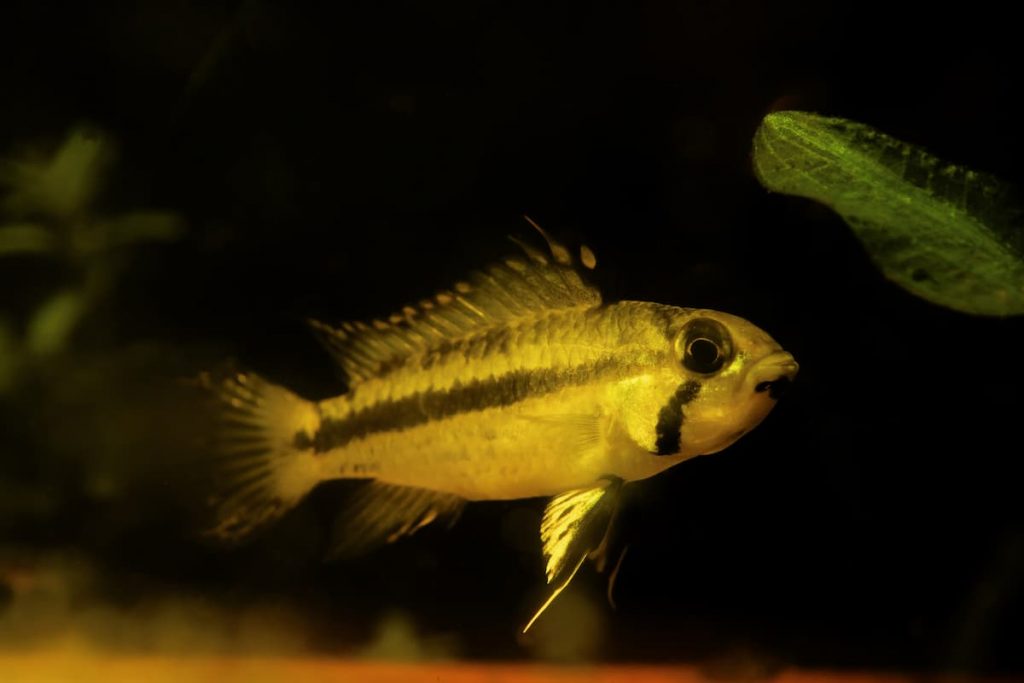
This particular fish genus is not at risk for any major diseases that are unique. But, they can be infected by diseases that plague common freshwater fish.
Two of the biggest examples are Ich and parasitic infections. As almost all of the issues this species can have is due to poor water quality, prevention is the best cure.
It is vital to be vigilant about the water quality of your tank. If you notice a fish suffering from Ich or parasites, it is important to isolate them and treat them with commercially available antibiotics.
| Best Antibiotics: | Standard commercial antibiotics |
| Treatments to Avoid: | None |
| Food Recommendations When Sick: | Pay close attention to how much they eat and adjust accordingly so there aren’t leftovers making the water quality worse. |
| Hospital Tank or Isolation Withing the Community Tank: | If your Apistos become ill, they should be isolated into a hospital tank. |
4 Facts About Apistogramma Cichlids
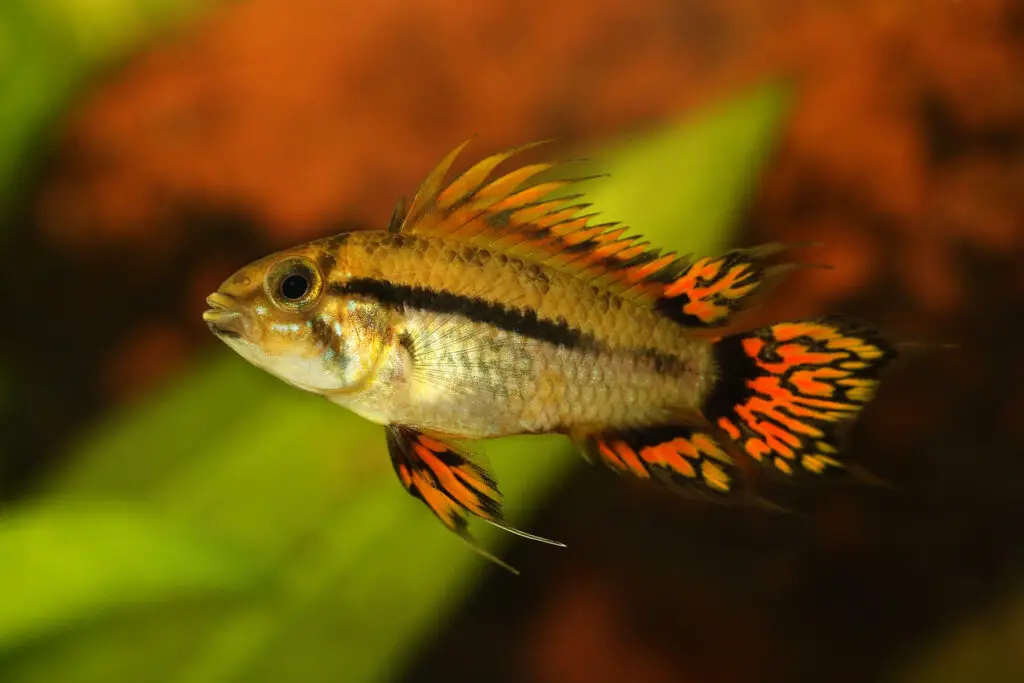
- This fish species originates from the Amazon rainforest in South America.
- Apistos are a breed (like Blue Plecos) that is easy to take care of the breed. As they lay eggs it is important to have a “cave” for your fish to spawn in.
- The female of the species is normally a gray or brown color. When it becomes time to breed the fish will turn yellow.
- All Apistogramma have common characteristics that define them, but there is a lot of variation in finage, body shape, color, and marking.
